#aja'ib al-makhluqat
Text
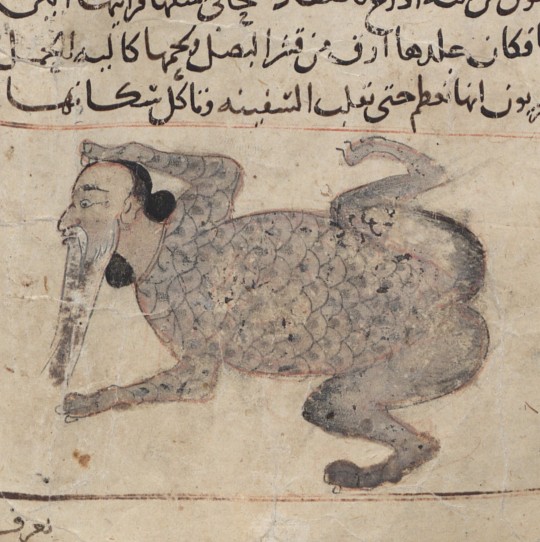
human-frog creature
in the oldest known manuscript of zakariyya' al-qazwini's "aja'ib al-makhluqat" ("the wonders of creatures and the marvels of creation"), wasit (iraq), c. 1280
source: Munich, BSB, Cod.arab. 464, fol. 69v
#13th century#hybrids#zakariyya' al-qazwini#al-qazwini#aja'ib al-makhluqat#the wonders of creatures and the marvels of creation#bestiary#medieval art#frogs
338 notes
·
View notes
Text

Abu Yahya Zakariya ibn Muhammad ibn Mahmud-al-Qazwini (ca. 1203-1283 CE), is known simply as al-Qazwini, Kitab Aja'ib al-makhluqat wa Gharaib al-Mawjudat, literally “The Wonders of Creation,” compiled in the middle 1200s in what is now Iran or Iraq.
185 notes
·
View notes
Text
Happy #InternationalCheetahDay!
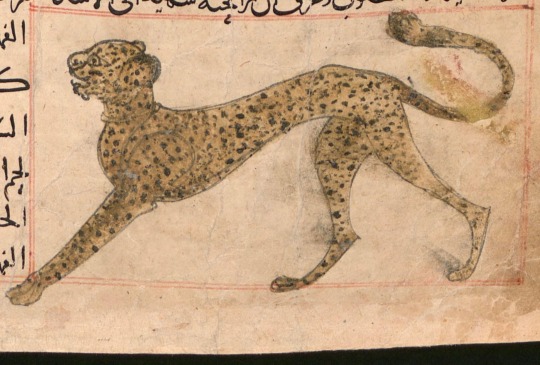
Here is the cheetah in Zakariya al-Qazwini's 'Aja'ib al-Makhluqat wa Ghara'ib al-Mawjudat (The Wonders of Creatures and the Marvels of Creation), an important work of Islamic cosmography which was probably first written in the 1260s, and for centuries after was reproduced across the Islamic world. This illuminated manuscript copy was made in Wasit, Iraq in 1280 CE and is the earliest known surviving version.
#animals in art#animal holiday#cheetah#feline#wild cat#Islamic art#Wonders of Creation#illuminated manuscript#illustration#natural history art#al-Qazwini#Manuscript Monday#International Cheetah Day
349 notes
·
View notes
Text
DRAGON QUEST'S LOCALIZATION SUCKS, ACTUALLY. PART 1
There's a thread blowing up on Japanese twitter right now about the poor quality of localization. It's the first time I've ever actually seen a japanese perspective on the topic, and it's been extremely gratifying to see a ton people from over there talk about specific translation issues they've seen or learn for the first time that japanese media is often given the short end of the stick here in the USA.




Most of the time over here in the US, criticism of localization gets shouted down as whiny fans who think they know better than the translators. It's been heartening to see that people from japan are also annoyed by it, and its inspired me to write up a whole long-ass rant I've had simmering in the back of my mind for years, so buckle up, long post(s) incoming:
Let's start at the beginning with the first thing that ever caused me to start thinking about localization. This little guy:

If you've played Dragon Quest in the past 2 decades, you probably know this guy by the name "Spiked Hare." Not me though! I got into DQ on the game boy, in the brief window of time where DQ's localization was handled by Nob Ogasawara, the same guy responsible for translating every pokemon game up until Platinum. In the DQ games Nob worked on, he chose to translate this guy's name as "Almiraj." Why the huge difference in translation? I'll get to that in a minute.
The almiraj is an extremely minor enemy in Dragon Quest 3. It's pretty weak, and it's only real defining feature is that it can occasionally cast sleep spells on your party members. It's just one of hundreds of monsters in that game, and aside from it's cute design, it's pretty forgettable. As a weird kid overly obsessed with linguistics though, its name always seemed odd to me. You don't really see words that end with a "J" in english. It stuck out enough that one night, when I was bored, I decided to google "almiraj" to figure out what the name meant. It sent me down a rabbit hole (almiraj hole?) that taught me all sorts of cool shit, and permanently altered the way I looked at localization. The path I tumbled down that night went something like this:
The Dragon Quest almiraj is named after the almiraj, a "real" mythical creature described as a hare with a large horn on its head.
The original inspiration for accounts of the almiraj (as well as the jackalope, wolpertinger, etc.) is likely the Shope papiloma Virus, which causes rabbits to grow weird, horn-like growths on their face and head.
It was described by Zakariya al-Qazwini, an Iranian lawyer, author, and all around knowledgeable guy who lived in the 13th century.
al-Qazwini described it in the Aja'ib al-Makhluqat, a massive cosmographical treatise that attempted to describe basically everything in the known universe at the time. It was so popular in the Islamic world that it was copied and translated into dozens of languages, which meant plenty of copies have survived intact to modern times.
The almiraj was brought into the limelight in modern fantasy when it was introduced in the first edition of Dungeons and Dragons, as a relatively weak and unassuming monster as part of a campaign to expand the game with monster suggestions from fans of the series.
Dungeons and Dragons-style role playing games were brought into the digital world with the release of the first Wizardry game in 1981.
Yuji Horii was a massive fan of Wizardry, which he first discovered as part of a developer exchange program when he visited America in 1983. Three years later, he decided to try and recreate the things he loved from the series for console gamers in Japan, and the the original Dragon Quest was born.
One little name was all it took to open up this entire through-line of history that I had no idea even existed before that night. It's a tapestry of human experiences over 800 years in the making, spanning continents, cultures, languages, and medium. It's probably because I'm the type of person who sits around thinking about stuff too much, but I honestly get a little emotional wondering what al-Qazwini would think if he could see the mythical creatures he described all those years ago as little dudes hopping around inside a computer.
And the thing is the tapestry doesn't end there! Dragon Quest is still pretty niche in the west, but in Japan it's fucking titanic. There's an urban legend that the Japanese government banned Square Enix from releasing Dragon Quest games on a weekday, because so many people would skip work or school that it would impact the economy. (It's not true by the way, but the fact that the rumor exists at all is a testament to how huge the series' influence is over there.) I don't think it would be an overstatement to say that what Lord of the Rings did to modern western fantasy, Dragon Quest did to modern Japanese fantasy. Almost every JRPG, manga, or anime with a fantasy setting has the fingerprints of Dragon Quest on it. Countless other works have been inspired by DQ, and those works will go on to inspire others. A million different threads weaving tapestries back and forth across time and borders, all over the globe. And the almiraj is a part of that! It might just be a single, tiny, white and purple thread, but it's still in there helping to tie things together.
So back to the question I asked earlier: Why is it "Almiraj" in Mr. Ogasawara's translation but "Spiked hare" in the current one? Simple: Nob actually translated the name.
You can see on the DQ wiki that the original japanese name of the monster is "アルミラージ" which is literally just "almiraj" written in katakana:
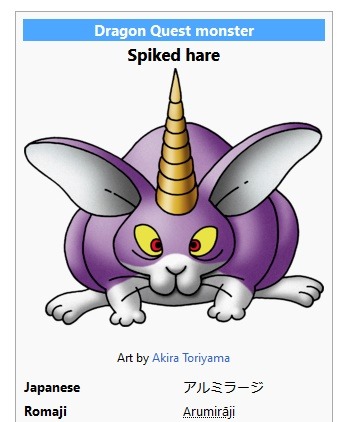
The current DQ team has instead decided that all monster names should be puns. I'm not against puns or anything. "Spiked hare" for a rabbit with a horn is great! I might even raise my eyebrows and exhale slightly if I read it for the first time. Dragon Quest in general tends to have a lot of goofiness in it, so it's not like puns are out of place or anything. My problem is that, by deciding to replace monster names arbitrarily like this, all the little threads start to come unraveled. You lose the ability to look back down the line and discover all these different connections to history and nature and art that you might not ever learn otherwise. The almiraj isn't the only monster to get this treatment. A huge portion of the monsters in Dragon Quest are taken from mythologies around the world, and many of their names are literally already in English, just written with katakana.
The almiraj sticks out in my mind as a particularly egregious example because of just how much I learned because of the foreign-sounding name, but there's plenty of other name changes that have resulted in straight up confusing, ambiguous, or otherwise stupid outcomes in the current localization.
CONTINUED IN PART 2
25 notes
·
View notes
Text

'Wonders of the Seven Seas' section of ‘Aja'ib al-makhluqat wa-ghara'ib al-mawjudat (Marvels of Things Created and Miraculous Aspects of Things Existing) by Abu Yahya Zakariya' ibn Muhammad al-Qazwini; ca. 1203-1283 AD.
1 note
·
View note
Text
20,000 words milestone
Since 20,000 words written is a bit of a milestone, here is some no context information about the 13th century…
Here are two religious manuscripts that may or may not be relevant:
Codex Gigas (aka The Devil's Bible)
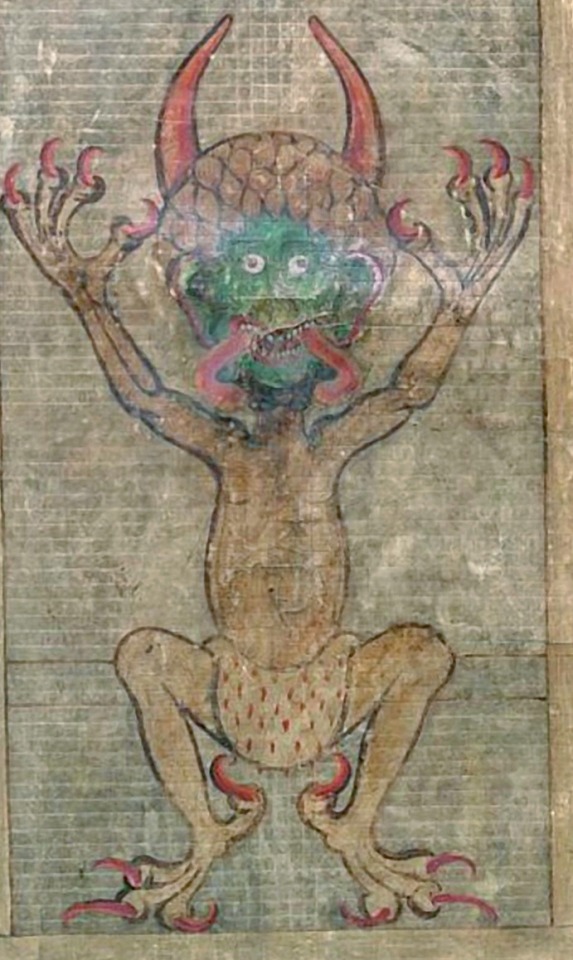
^ So, this is a depiction of the devil found in a codex (basically an old handwritten book) from early 13th century, what is now the, Czech Republic.
Here is the Wikipedia article. It's written in Latin, which I recently discovered is a language you can learn on Duolingo... probably not 13th century Latin though.
Aja'ib al-Makhluqat (The Wonders of Creatures and the Marvels of Creation)

^ This is the Archangel Gabriel who is looking quite stylish and colourful. The picture itself is from a 14th century manuscript, but the original work was written by Zakariya al-Qazwini in the 13th.
It was written in Arabic, which as far as I can tell would have been in 'Classical Arabic' which differs somewhat from the 'Modern Standard Arabic' used today.
I can't remember how I found this, but here is the Wikipedia article.
---
So, 13th century England or 13th century Scotland...
Kingdom of Alba
Well, I haven't been to either England or Scotland, but neither existed as we know them in the 13th century. Something that did exist from 900AD till 1296AD was the Kingdom of Alba. Which seems to me to just be the Scottish Gaelic word for... Scotland.
There is a lot of information about Scotland in the High Middle Ages, far more than I had time or energy to read about. But the King during the 1240's was:

^ Alexander II (1198 - 1249), King of Scots. And here is his Wikipedia article, and that's his seal.
He was the "only Scottish king to take his invasion force all the way to the south coast of England", and signed the "Treaty of York (1237) which defined the boundary between England and Scotland".
So, the 13th century wasn't boring, if you are a historian... which I am not.
Getting slightly back on topic:
Church architecture from 13th century Scotland has a few examples still standing that are easy finds.

^ Dunblane Cathedral, in Dunblane, Scotland, has been restored... but would have been restored using materials and techniques that would make it still a useful example of a 13th century church. (Even though it was originally built between the 11th and 15th centuries... like I said, I'm not a historian.)

^ The ruins of Sweetheart Abbey, in New Abbey, Scotland, was founded in the late 13th century. I think it's held up pretty well, considering it has been abandoned since 1624.

^ My personal favourite: The ruins of Elgin Cathedral, in Elgin, Scotland. Built in 1224 on land granted by the aforementioned King Alexander II.
I mean, it had a tendance to be burnt down... at least three times... so it's probably more of a 15th century example, but it's pretty.
---
Assorted people of the 13th century:
Francis of Assisi
Francis of Assisi (1181 - 1226), was a 13th century monk who lived and died in what we would now think of as Italy. He is not relevant to what I am writing, however his Wikipedia page has a detailed painting of what a 13th century monk would wear… although it was painted in the 17th century so…

^ Francis of Assisi.
Hugh of Saint-Cher
Hugh of Saint-Cher (1200 - 1263), was another 13th century monk, this time a Bishop, who…wore glasses! That’s it, that's why I find him interesting. Born in what is now France and dying in what is now Italy, the painting of him wearing a pair of eyeglasses is one of the (if not the) first depictions we have of someone who wore reading glasses. Sunglasses were also invented in roughly the same timeframe in China.

---
Miscellaneous...
While not particularly relevant, I of course spent some time looking at fashion trends of the 13th century... and learning of the existence of sumptuary laws, which are also not relevant but confirm the existence of the fashion police.
And I have yet to finish watching the BBC docuseries on 'How To Build A 13th Century Castle'.
I'll end with: Medieval names we can all enjoy...
#13th century#medieval history#13th century fic#medieval scotland#medieval religion#apparently you can take me out of academia but...
0 notes
Photo

"Aja'ib al-Makhluqat" (Les merveilles de la Création, de Zakariya ibn Muhammad al-Qazwini (1203-1283) - L'Ange Ruh tenant les sphères célestes.
"Aja'ib al-Makhluqat" (Les merveilles de la Création, de Zakariya ibn Muhammad al-Qazwini (1203-1283) - L'Ange Ruh tenant les sphères célestes. ]
#aja'ib al-makhluqat#Les merveilles de la Création#Zakariya ibn Muhammad al-Qazwin#L'Ange Ruh#sphères célestes
2 notes
·
View notes
Photo

Water Horse (Faras al-Ma), Whale (Qatus), from Aja'ib al-makhluqat (Wonders of Creation) by al-Qazvini early 15th century, Iraq or Eastern Turkey.
10 notes
·
View notes
Photo

Zakariya ibn Muhammad ibn Mahmud al-Qazwini (d.1283 AD), Aja'ib al-makhluqat ('On the Wonders of Creation')
Persian manuscript - India, Mughal, late 17th/18th century
Sotheby’s
270 notes
·
View notes
Photo

Manuscript of the 'Aja'ib al-makhluqat (Wonders of Creation) of Qazwini c. 1650-1700 https://t.co/JlQUoY54Jo
6 notes
·
View notes
Photo









1) Ursa Minor and Ursa Major
2) Draco
3) Lyre and Cygnus
4) Pegasus and Andromeda
5) Aries
6) Taurus and Gemini
7) Scorpio and Sagittarius
8) Capricorn and Aquarius
9) Centaurus and Lupus
10) Hydra, Crater, and Corvus
Images taken from theTurkish version of 'Aja'ib al-makhluqat (Wonders of creation) by Zakariya al-Qazwini (died 692 AH/AH 1293) completed in 1121 AH/AD 1717 by Muhammad ibn Muhammad Shakir Ruzmah-'i Nathani.
Walters Art Museum
Wikimedia
#bestiary#illuminated manuscript#Muhammad ibn Muhammad Shakir Ruzmah-'i Nathan#Zakariya al-Qazwini#constellation#Turkish
272 notes
·
View notes
Text

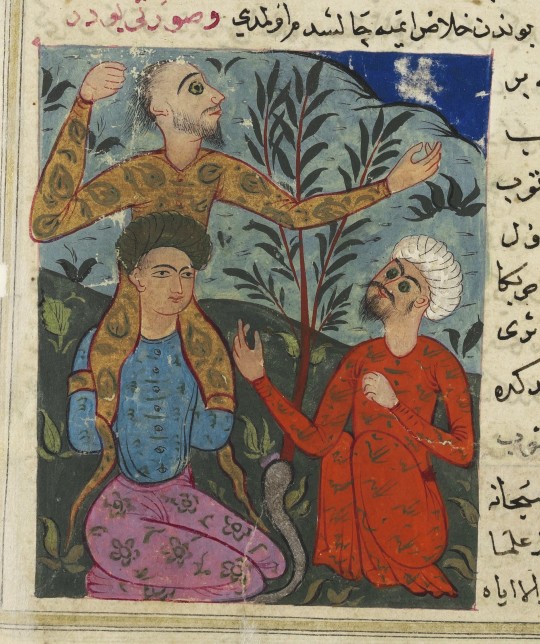
the inhabitants of saksar island
in a turkish edition of zakariyya' al-qazwini's "aja'ib al-makhluqat" ("the wonders of creatures and the marvels of creation"), anatolia or persia, 1717
source: Hamburg, Staats- und Universitätsbibl., Cod. orient. 342, fol. 83v
#18th century#zakariyya' al-qazwini#al-qazwini#aja'ib al-makhluqat#the wonders of creatures and the marvels of creation#hybrids#himantopodes#saksar island#illuminated manuscript
128 notes
·
View notes
Photo

Raghib Al-Isfehani ( Abul-Qasim al-Hussein bin Mufaddal bin Muhammad)
from ʻAjāʼib al-makhlūqāt wa-gharāʼib al-mawjūdāt (The wonders of creation, or literally, Marvels of things created and miraculous aspects of things existing) by Zakriya ibn Muhammad al-Qazwini (circa 1203-83) is among the best known texts of the Islamic world. It is often referred to as "The Cosmography."
The work begins with an introduction, and is followed by two sections, the first on supra-terrestrial, the second on terrestrial creatures. Al-Qazwini concludes his work with a section on monsters and angels. The genre of Aja'ib al-makhluqat (The wonders of creation), of which al-Qazwini's work is the most famous example, includes texts in Arabic and Persian that describe the marvels of the heavens and the earth. Numerous manuscripts of al-Qazwini's work have survived, as have several Persian and Turkish translations of illustrations.
#Abul-Qasim al-Hussein bin Mufaddal bin Muhammad#Raghib Al-Isfehani#the wonders of creation#fish#islamic art#arabic#al-Qazwini
1K notes
·
View notes
Text
One more for #WorldGiraffeDay:

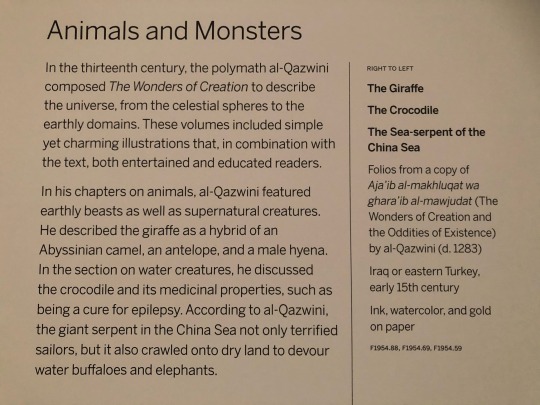
The Giraffe, folio from Aja'ib al-makhluqat wa ghara'ib al-mawjudat (aka The Wonders of Creation) by al-Qazwini (d. 1283), Iraq or eastern Turkey, early 15th c., F1954.88. Ink, watercolor, gold on paper.
Seen at the Smithsonian National Museum of Asian Art in 2020 (they have a rotating display of pages).
“…he described the giraffe as a hybrid of an Abyssinian camel, an antelope, and a male hyena.”
#animals in art#Word Giraffe Day#giraffe#Islamic art#miniature art#illuminated manuscript#medieval art#Near Eastern art#Middle Eastern art#book art#book illustration#animal holiday#World Giraffe Day#museum visit#Smithsonian National Museum of Asian Art#The Wonders of Creation#al Qazwini
37 notes
·
View notes
Photo

Qazwini's “Aja'ib al-Makhluqat: Obverse: Scorpio and Sagittarius” (c. 1570). Persian or Indian.
16 notes
·
View notes
Photo

"The Tortoise", Folio from an `Aja'ib al-Makhluqat (Wonders of Creation) of Qazwini by Zakaria bin Muhammad bin Mahmud Abu Yahya Qazwini, Islamic Art
Medium: Opaque watercolor and gold on paper
Bequest of George D. Pratt, 1935 Metropolitan Museum of Art, New York, NY
http://www.metmuseum.org/art/collection/search/450599
33 notes
·
View notes